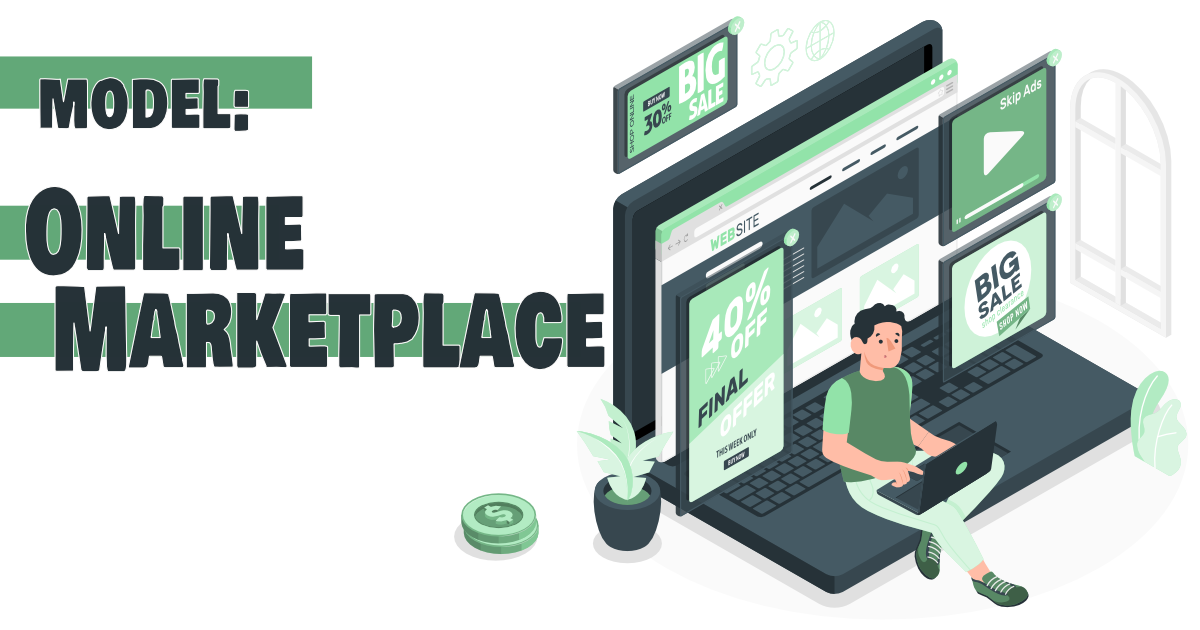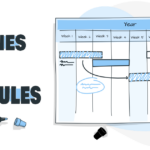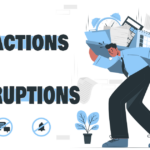An online marketplace is a platform that allows multiple third-party sellers to offer their products or services to a common customer base. This business model has emerged as one of the most popular e-commerce models and has revolutionized the way we shop online. With the rise of digital commerce, the online marketplace model has become a key player in the retail industry, providing customers with a vast array of products and services to choose from, all under one roof. In this article, we will delve into the details of the online marketplace model, including its features, benefits, and how it works.
Overview of online marketplace model
An online marketplace model is a business model where an e-commerce platform acts as a facilitator between buyers and sellers, offering them a platform to connect, negotiate, and transact with each other. The marketplace operator earns revenue by charging sellers fees for listing products, handling payments, providing customer support, and other value-added services.
The online marketplace model has gained immense popularity in recent years due to its numerous advantages. It eliminates the need for businesses to set up and maintain their own e-commerce website and offers access to a large customer base. It also allows businesses to reach new markets and customer segments and provides them with a cost-effective way to grow their business.
How does Online Marketplace Model work?
The online marketplace model operates by providing a platform for buyers and sellers to connect and transact with each other. Buyers can browse through a wide range of products, compare prices, and purchase products from multiple sellers. Sellers can list their products, manage their inventory, and receive payment for their products through the platform. The marketplace operator earns revenue by charging sellers fees for listing products, handling payments, providing customer support, and other value-added services.
Relevant Examples
- Amazon – Amazon is the largest online marketplace in the world, offering a wide range of products and services to customers globally. It was founded in 1994 and has since expanded to include various categories such as books, electronics, fashion, and groceries.
- eBay – eBay is one of the oldest online marketplaces, founded in 1995. It operates as a peer-to-peer platform where individuals can buy and sell items to each other. It is a popular platform for vintage and collectible items, as well as for buying and selling new and used goods.
- Etsy – Etsy is a global online marketplace specializing in handmade and vintage goods, as well as unique factory-manufactured items. It was founded in 2005 and has since become a popular platform for artists, crafters, and small business owners to sell their wares.
- Alibaba – Alibaba is a Chinese online marketplace that offers a wide range of products and services, including wholesale goods and services to businesses. It was founded in 1999 and has since become one of the largest online marketplaces in the world, serving customers globally.
- Flipkart – Flipkart is an Indian online marketplace founded in 2007 that specializes in electronics, fashion, and home goods. It has since expanded to include a wide range of categories, making it a popular platform for online shopping in India.
- Rakuten – Rakuten is a Japanese online marketplace founded in 1997 that offers a wide range of products and services, including travel, food, and home goods. It has since expanded globally and is now a popular platform for online shopping in various countries.
- Newegg – Newegg is an American online marketplace specializing in computer hardware and consumer electronics. It was founded in 2001 and is now a popular platform for tech enthusiasts and gamers.
- Lazada – Lazada is a Southeast Asian online marketplace founded in 2012 that offers a wide range of products and services, including fashion, electronics, and home goods. It is now a popular platform for online shopping in various countries in the region.
Real-Life Examples
- A small handmade soap manufacturer lists their products on Amazon and starts receiving orders from customers across the country.
- A local bookstore starts selling their books on eBay and reaches a global audience, increasing their sales.
- An artisan selling handmade jewelry on Etsy starts receiving orders from customers in different countries, expanding their customer base.
Best Practices for Online Marketplace Model
- Offer a wide range of products: Offer a wide range of products to attract a larger customer base.
- Provide seamless payment options: Offer multiple payment options to make the checkout process easy and convenient for customers.
- Offer excellent customer service: Provide prompt and efficient customer support to ensure a positive customer experience.
- Offer competitive pricing: Offer competitive pricing to attract and retain customers.
- Offer fast and reliable delivery: Ensure fast and reliable delivery to retain customers and increase repeat purchases.
Actionable Tips
- Monitor competitor pricing and adjust your pricing strategy accordingly.
- Offer promotions and discounts to attract new customers and increase sales.
- Regularly evaluate and improve your customer service processes.
- Continuously optimize your website for better search engine rankings and improved customer experience.
In conclusion, the online marketplace model offers a cost-effective way for businesses to reach new markets and customer segments and grow their business. By offering a wide range of products, providing seamless payment options, offering excellent customer service, offering competitive pricing, and offering fast and reliable delivery, businesses can attract and retain customers and increase their sales.
Types of products and services offered
Online marketplace platforms offer a wide range of products and services, from physical goods to digital services. They cater to a diverse set of customer needs and preferences. Some of the popular categories of products and services offered by online marketplaces include:
- Consumer electronics
- Fashion and apparel
- Home and kitchen products
- Beauty and personal care products
- Food and grocery items
- Books, music, and entertainment
- Services like home repair, cleaning, and pet-sitting
- Digital services like web design, content writing, and software development
Offering a wide range of products and services helps online marketplaces cater to a larger customer base and increase their sales and revenue. It also helps attract new customers who might not have otherwise considered shopping on their platform.
Online marketplaces offer these products and services through partnerships with merchants and vendors who list their products and services on the platform. The marketplace platform takes care of marketing, payment processing, and customer service while the merchants handle the delivery and shipment of the products and services.
Relevant Examples
- Amazon: Amazon offers a vast range of products and services, including consumer electronics, fashion, home goods, books, music, and services like home repair and pet-sitting.
- eBay: eBay is popular for its wide range of consumer goods, including electronics, fashion, home goods, collectibles, and art.
- Etsy: Etsy is a popular marketplace for handmade and vintage products, including jewelry, clothing, home décor, and art.
- Flipkart: Flipkart is a popular Indian online marketplace that offers a wide range of products, including electronics, fashion, home goods, books, and groceries.
- Alibaba: Alibaba is a Chinese online marketplace that offers a wide range of products, including consumer electronics, fashion, home goods, and food items.
- Lazada: Lazada is a Southeast Asian online marketplace that offers a wide range of products, including electronics, fashion, home goods, and beauty products.
Real Life Examples
- A home decor store listing their products on Amazon to reach a larger customer base.
- A handmade jewelry maker listing their products on Etsy to sell to customers interested in unique and handcrafted items.
Best Practices
- Offer products and services that cater to a wide range of customer preferences and needs.
- Partner with reliable and trustworthy merchants and vendors to offer high-quality products and services.
- Regularly monitor and update the product and service offerings to ensure they meet customer demands and expectations.
Actionable Tips
- Conduct market research to identify popular and in-demand products and services.
- Offer competitive pricing for products and services to attract customers.
- Offer promotions and discounts to incentivize customers to purchase from your platform.
In conclusion, offering a wide range of products and services is essential for the success of an online marketplace. It helps attract a larger customer base and increase sales and revenue. By partnering with reliable merchants and vendors, and regularly monitoring and updating the product and service offerings, online marketplaces can ensure they meet the changing demands and expectations of their customers.
Seller registration and management
Seller registration and management is the process of enrolling and managing sellers on an online marketplace platform. This process involves verifying the identity of sellers, ensuring compliance with platform policies and procedures, and providing support for sellers as they list and sell their products or services.
Online marketplace platforms need to regulate the sellers who are using their platform to ensure that they are legitimate and meet the platform’s standards for quality, safety, and customer satisfaction. This helps to protect the reputation of the platform and maintain trust with its customers.
The process of seller registration and management typically involves the following steps:
- Seller sign-up: The seller creates an account on the platform and provides information such as name, address, business details, and payment information.
- Verification: The platform verifies the identity of the seller and checks that they meet the platform’s standards and policies.
- Listing products: Once the seller has been approved, they can start listing their products or services for sale on the platform.
- Order management: The platform provides tools for sellers to manage orders, track shipments, and communicate with customers.
- Payment processing: The platform processes payments from customers and transfers the funds to the seller.
Relevant Examples
- Amazon: Amazon requires sellers to complete a registration process and provides tools for managing their sales, including order management and payment processing.
- eBay: eBay has a seller registration process that requires verification of the seller’s identity and compliance with platform policies. Sellers can use eBay’s tools to list and manage their products and sales.
- Etsy: Etsy requires sellers to complete a registration process and provides tools and resources to help them manage their sales, including order management, payment processing, and shipping.
Real Life Examples
- A small business owner creates an account on Amazon to sell handmade soap products. They complete the seller registration process, list their products, and start receiving orders from customers.
- A vintage clothing seller registers on eBay to sell their products to customers around the world. They use eBay’s tools to manage their sales, communicate with customers, and process payments.
- An artist signs up on Etsy to sell their handmade pottery. They use Etsy’s platform to list their products, manage orders, and process payments from customers.
Best Practices
- Ensure that the registration process is clear, easy to follow, and not overly time-consuming.
- Verify the identity of sellers to ensure that they are legitimate and meet the platform’s standards.
- Provide clear and concise guidelines and policies for sellers to follow.
- Offer support and resources to help sellers manage their sales and navigate any challenges they may encounter.
- Continuously monitor and evaluate the performance of sellers to ensure they meet the platform’s standards.
Actionable Tips
- Streamline the seller registration process by automating tasks and reducing manual data entry.
- Use a secure identity verification service to ensure that sellers are who they claim to be.
- Provide clear and concise guidelines for sellers to follow and enforce them consistently.
- Offer a range of support options, including email, phone, and live chat, to help sellers with any issues they may encounter.
- Use data and analytics to monitor the performance of sellers and identify areas for improvement.
In cconclusion, seller registration and management is an important aspect of operating an online marketplace platform. By verifying the identity of sellers and providing support and resources to help them succeed, platforms can build trust with customers and ensure the quality and safety of products and services offered on the platform.
Customer demographics
Why is Customer Demographics Important?
Knowing the demographics of your customers is critical for the success of your business. By understanding the characteristics of your target audience, you can tailor your products and services to meet their needs and preferences. This can help you increase sales, improve customer satisfaction, and build a loyal customer base.
How to Analyze Customer Demographics?
- Collect Data: Gather data on your customers through surveys, online analytics, and customer feedback.
- Organize Data: Organize the data you have collected into categories such as age, gender, income, education, and location.
- Create Customer Personas: Based on the data, create customer personas that represent your target audience.
- Analyze Data: Analyze the data to identify patterns and trends in your customer demographics.
- Create a Marketing Strategy: Use the insights from your customer demographics analysis to create a marketing strategy that targets your target audience.
Relevant Examples
- Amazon – Amazon uses customer demographics data to personalize the shopping experience for its customers. For example, if a customer is a young adult, Amazon may recommend popular products in that demographic.
- Ebay – Ebay also uses customer demographics data to personalize the shopping experience for its customers. Ebay may recommend products based on a customer’s location, such as popular items in their area.
- Etsy – Etsy uses customer demographics data to create targeted marketing campaigns. For example, if a customer is a young adult female, Etsy may recommend handmade jewelry products in that demographic.
Real Life Examples
A clothing store may use customer demographics data to determine the most popular styles among its target audience. For example, if the store’s target audience is young adults, it may focus on trendy and fashionable clothing items.
Best Practices
- Regularly update your customer demographics data to ensure accuracy.
- Use customer demographics data to inform your product development and marketing strategies.
- Create customer personas that accurately reflect your target audience.
- Use customer demographics data to segment your target audience and create targeted marketing campaigns.
Actionable Tips
- Use social media analytics to gather data on your followers.
- Conduct regular customer surveys to gather demographic information.
- Use Google Analytics to track the demographics of website visitors.
- Use A/B testing to determine which marketing strategies are most effective for your target audience.
In conclusion, customer demographics is a critical component of any successful business. By understanding the characteristics of your target audience, you can create products and services that meet their needs and preferences, increase sales, and build a loyal customer base. Regularly updating your customer demographics data and using it to inform your marketing and product development strategies is essential for the long-term success of your business.
Revenue generation methods
Revenue generation in an online marketplace model involves a number of methods, including fees, commissions, and ads. Online marketplaces make money by charging fees for services rendered, taking a commission on each transaction, and selling ads.
Revenue generation is an important aspect of running an online marketplace as it helps to sustain the platform and grow the business. By generating revenue through fees, commissions, and ads, online marketplaces can continue to offer a valuable service to customers and merchants while also making a profit.
Fees: Online marketplaces can charge fees for services such as listing fees, transaction fees, and subscription fees. For example, Amazon charges a fee for sellers to list their products and a fee for each sale made through the platform.
Commissions: Online marketplaces can generate revenue by taking a commission on each transaction made through the platform. This is a percentage of the sale price and can vary based on the product or service being sold.
Ads: Online marketplaces can also generate revenue by selling ads to businesses. These ads can appear in various forms, such as banner ads or sponsored listings, and can be targeted to specific demographics or categories of products.
Relevant Examples
- Amazon charges a fee for sellers to list their products and takes a commission on each sale made through the platform.
- eBay charges a fee for sellers to list their products and takes a commission on each sale made through the platform.
- Etsy charges a fee for sellers to list their products and takes a commission on each sale made through the platform.
Real Life Examples
- Amazon has grown into one of the largest e-commerce companies in the world by generating revenue through fees, commissions, and ads.
- eBay has also grown into a successful online marketplace by generating revenue through fees, commissions, and ads.
Best Practices
- Be transparent about fees and commissions to avoid any confusion or disputes with customers and merchants.
- Offer competitive fees and commissions to attract and retain customers and merchants.
- Offer a range of ad options to cater to different business needs and budgets.
Actionable Tips
- Regularly review and adjust fees and commissions to ensure they remain competitive and relevant.
- Continuously monitor and optimize ad performance to maximize revenue potential.
- Offer value-added services to customers and merchants, such as detailed analytics or personalized support, to increase the perceived value of the platform and generate additional revenue.
In conclusion, revenue generation through fees, commissions, and ads is a crucial aspect of running an online marketplace. By offering competitive fees and commissions, selling ads, and offering value-added services, online marketplaces can continue to grow and sustain their business.
Payment and delivery options
Payment and delivery options are crucial for the success of an online marketplace. They dictate the customer’s purchasing experience, and can significantly impact the number of sales made.
Online marketplaces must offer a variety of payment and delivery options to meet the diverse needs of their customers. Consumers are increasingly demanding flexible and convenient payment and delivery options, and marketplaces must respond to this demand to remain competitive.
There are several payment and delivery options available for online marketplaces, including credit/debit cards, digital wallets, cash on delivery (COD), and shipping carriers. It’s important for marketplaces to choose the options that best suit their target customers, product categories, and overall business strategy.
Payment and delivery options for an online marketplace model include:
- Credit/debit card payment
- Online payment systems such as PayPal, Apple Pay, and Google Pay
- Bank transfers
- Cash on delivery
- Mobile payments
- Gift cards and vouchers
- Cryptocurrency
Delivery options include:
- Shipping via a courier service
- In-store pickup
- Same-day delivery
- Next-day delivery
- Two-day delivery
- International shipping
Relevant Examples
- Amazon offers a variety of payment options including credit/debit cards, Amazon Pay, and COD. They also offer multiple shipping options, including standard shipping, same-day delivery, and Prime two-day shipping for eligible products.
- eBay offers payment options such as credit/debit cards, PayPal, and COD. They also partner with various shipping carriers to provide customers with multiple delivery options.
- Etsy provides payment options such as credit/debit cards, PayPal, and Etsy Payments. Shipping options include standard shipping, expedited shipping, and local delivery.
Real Life Examples
A customer looking to purchase handmade jewelry may opt for COD, while another customer may prefer to pay using a digital wallet and have the item delivered to their office.
Best Practices
- Offer a variety of payment options to accommodate different customer preferences.
- Partner with reputable shipping carriers to provide reliable and efficient delivery services.
- Provide transparent delivery timelines and shipping costs to ensure a positive customer experience.
Actionable Tips
- Consider offering COD for customers who are hesitant to make online payments.
- Partner with multiple shipping carriers to provide customers with a range of delivery options.
- Offer free or discounted shipping for purchases over a certain amount to encourage customers to spend more.
In conclusion, the payment and delivery options offered by an online marketplace play a critical role in determining customer satisfaction and sales. Marketplaces must offer a range of options to meet the diverse needs of their customers and remain competitive.
Customer service and support
Customer service and support play a crucial role in ensuring the success of an online marketplace. It is essential to provide excellent customer service and support to maintain customer satisfaction, increase customer loyalty, and ultimately drive sales.
Customer service and support refer to the various channels and methods that an online marketplace provides to its customers to address their queries, complaints, and feedback. This can include live chat, phone support, email support, help center, and more.
An online marketplace model operates by connecting buyers and sellers, facilitating transactions and providing a platform for the exchange of goods and services. The success of an online marketplace depends on the satisfaction of its customers. Providing excellent customer service and support helps to increase customer satisfaction and ultimately drives sales.
The online marketplace should provide multiple channels for customers to reach out for support, such as a dedicated email address, phone support, live chat, and a comprehensive help center. The online marketplace should also ensure that customer support is available 24/7 and staffed by trained personnel who are able to assist customers with any issues or concerns.
Relevant Examples
- Amazon provides 24/7 customer service and support through phone support, live chat, and email. They also have a comprehensive help center with articles and resources to assist customers with their issues.
- Ebay provides customer support through a help center, live chat, email, and phone support. They also have a resolution center to help customers resolve any disputes with sellers.
- Etsy provides customer support through live chat, email, and phone support. They also have a comprehensive help center with articles and resources to assist customers with their issues.
Real Life Examples
A customer has received a damaged product and contacts the online marketplace for support. The customer service representative should assist the customer by providing a replacement product or issuing a refund, depending on the customer’s preference.
Best Practices
- Provide multiple channels for customer support, including phone support, live chat, email, and a comprehensive help center.
- Ensure that customer support is available 24/7.
- Staff customer support with trained personnel who are able to assist customers with any issues or concerns.
- Respond to customer inquiries in a timely and professional manner.
- Continuously monitor customer feedback and make improvements to the customer service and support process as necessary.
Actionable Tips
- Provide clear and concise information on how to contact customer support on your online marketplace’s website.
- Train customer support staff on the products and services offered on your online marketplace to ensure they are able to assist customers effectively.
- Continuously monitor customer feedback and make improvements to the customer service and support process as necessary.
In conclusion, customer service and support is an essential aspect of any online marketplace model. Providing excellent customer service and support helps to increase customer satisfaction, increase customer loyalty, and ultimately drive sales. By providing multiple channels for customer support, ensuring customer support is available 24/7, and staffing customer support with trained personnel, an online marketplace can provide the customer service and support necessary to succeed.
Seller protection and dispute resolution
Seller protection and dispute resolution refer to the measures and processes put in place by online marketplaces to ensure that both buyers and sellers are protected and that any disputes that may arise are resolved fairly and effectively.
Seller protection and dispute resolution are critical components of a successful online marketplace model, as they help to build trust between buyers and sellers and ensure that both parties are satisfied with the transactions they make. Without effective protection and dispute resolution mechanisms in place, sellers may be hesitant to sell their products or services on the platform, and buyers may be reluctant to purchase, leading to decreased activity and lower revenue for the marketplace.
Seller protection and dispute resolution mechanisms are implemented through a variety of methods, including buyer protection programs, dispute resolution processes, and clear terms of service and policies. These measures may include policies for handling fraud, chargebacks, and other disputes, as well as tools for tracking and reporting on transactions.
Relevant Examples
- Amazon: Amazon provides a comprehensive seller protection program, which includes a number of features such as a dispute resolution process, protection against fraudulent transactions, and chargeback protection.
- eBay: eBay has a dedicated Resolution Center where buyers and sellers can resolve disputes, as well as a Money Back Guarantee policy to protect buyers.
- Etsy: Etsy provides a dispute resolution process, as well as a range of tools and resources to help sellers protect their businesses and resolve disputes effectively.
Real Life Examples
For example, if a buyer receives a product that is different from what they purchased, they can use the dispute resolution process to report the issue to the marketplace, which will then investigate and work with both parties to resolve the issue. Similarly, if a seller encounters a fraudulent transaction, they can use the seller protection mechanisms to report the issue and receive assistance in resolving the matter.
Best Practices
- Clearly communicate policies and procedures: Clearly communicate the policies and procedures in place for seller protection and dispute resolution, including how disputes will be handled and how the platform will support sellers in the event of a problem.
- Provide resources and tools: Provide sellers with access to resources and tools that can help them resolve disputes and protect their businesses, such as transaction tracking and reporting tools.
- Foster a sense of community: Foster a sense of community on the platform by encouraging communication and collaboration between buyers and sellers, as this can help to build trust and reduce the likelihood of disputes.
Actionable Tips
- Develop a comprehensive seller protection policy: Develop a comprehensive seller protection policy that outlines the measures and processes in place to protect sellers from fraudulent transactions, chargebacks, and other issues.
- Offer dispute resolution options: Offer a range of dispute resolution options to buyers and sellers, including a dedicated dispute resolution process, tools for reporting and tracking transactions, and support from the platform’s customer service team.
- Encourage communication: Encourage communication between buyers and sellers by providing features such as private messaging, review systems, and forums.
In conclusion, seller protection and dispute resolution are essential components of a successful online marketplace model, as they help to build trust between buyers and sellers and ensure that transactions are completed satisfactorily. By implementing effective protection and dispute resolution mechanisms, marketplaces can encourage increased activity and revenue, while providing buyers and sellers with the confidence and security they need to participate in the platform.
Data analysis and optimization
Data analysis and optimization are crucial elements in the success of an online marketplace model. It involves collecting, organizing, and analyzing large amounts of data to make informed decisions that can lead to better results and increased efficiency. In this article, we will explore the various steps involved in the data analysis and optimization process.
Data analysis is the process of collecting and examining data to understand trends, patterns, and insights that can be used to make better decisions. Optimization refers to the process of improving a system, process, or model based on the data obtained through analysis. In the context of an online marketplace model, data analysis and optimization involve analyzing data related to customer behavior, sales, marketing, and operations to identify areas of improvement and make necessary changes.
Data analysis and optimization play a critical role in the success of an online marketplace model as it allows for a more informed decision-making process. It helps to identify areas of improvement in the customer experience, marketing strategies, and operational processes, which can lead to increased sales and revenue. Furthermore, optimization helps to reduce costs, improve efficiency, and increase customer satisfaction.
Steps in Data Analysis and Optimization
- Data Collection: The first step in data analysis and optimization is to collect data from various sources, including customer behavior, sales, marketing, and operations.
- Data Organization: The next step is to organize the data into a format that can be easily analyzed, such as a spreadsheet or database.
- Data Cleaning: Once the data is collected and organized, it is important to clean the data to remove any errors or inconsistencies that could affect the accuracy of the analysis.
- Data Analysis: The next step is to analyze the data to identify trends, patterns, and insights. This can be done using various techniques, such as statistical analysis, data visualization, and machine learning algorithms.
- Optimization: Based on the insights obtained from data analysis, the next step is to make informed decisions and implement changes to improve the online marketplace model. This can include changes to the customer experience, marketing strategies, and operational processes.
Best Practices
- Regular Data Collection: Regular data collection is crucial for the success of data analysis and optimization. By collecting data on a regular basis, businesses can stay up-to-date on the latest trends and insights.
- Use Advanced Analytics Tools: Advanced analytics tools, such as machine learning algorithms, can be used to analyze large amounts of data and identify trends and patterns that would otherwise be difficult to see.
- Collaborate with Stakeholders: Collaboration with stakeholders, such as customers, sellers, and partners, is essential in the data analysis and optimization process. By gathering feedback and input from these stakeholders, businesses can make more informed decisions.
Actionable Tips
- Set specific goals for the data analysis and optimization process.
- Use data visualization tools to make data analysis easier and more intuitive.
- Regularly review and update the data analysis and optimization process to ensure it is aligned with the goals of the online marketplace model.
In conclusion, data analysis and optimization play a critical role in the success of an online marketplace model. By collecting and analyzing data, businesses can identify areas of improvement and make informed decisions that can lead to increased sales and revenue. By following best practices and actionable tips, businesses can ensure they are taking full advantage of the data analysis and optimization process.
Marketing and advertising strategies
Marketing and advertising strategies play an important role in the success of an online marketplace. It is important for marketplace operators to develop and implement effective marketing and advertising strategies to reach potential customers and grow the customer base.
Marketing and advertising strategies are methods used to promote the products or services offered on an online marketplace. These strategies can be used to create awareness about the marketplace, generate interest in the products and services offered, and drive traffic and sales.
Marketing and advertising strategies are critical for online marketplaces to reach potential customers and increase sales. Without effective marketing and advertising strategies, it can be difficult for online marketplaces to gain traction and grow their customer base. In a crowded online marketplace space, having a strong marketing and advertising presence can help set a marketplace apart from its competitors.
To develop effective marketing and advertising strategies, marketplace operators should first understand their target audience, their competitors, and the products or services they offer. Once this information is gathered, operators can use a combination of traditional and digital marketing techniques, such as search engine optimization (SEO), social media advertising, email marketing, and influencer marketing, to reach potential customers and drive sales.
Relevant Examples
- Amazon: Amazon uses a combination of SEO, email marketing, and targeted advertising to reach potential customers and promote its products and services.
- Etsy: Etsy leverages social media advertising, influencer marketing, and email marketing to reach its target audience of creative and unique product buyers.
- Ebay: Ebay uses targeted advertising, email marketing, and SEO to reach potential customers and promote its products and services.
Real Life Examples
An example of a successful marketing and advertising strategy for an online marketplace is the use of influencer marketing. Many online marketplaces partner with popular social media influencers to promote their products and services to a large and engaged audience.
Best Practices
- Know your target audience and understand their needs and preferences.
- Use a combination of traditional and digital marketing techniques to reach potential customers.
- Continuously monitor and adjust marketing and advertising strategies to ensure they are effective and achieving desired results.
- Collaborate with influencers and partner with other businesses to reach new audiences and drive sales.
Actionable Tips
- Invest in SEO to improve search engine rankings and reach potential customers.
- Utilize social media advertising to reach targeted audiences and promote products and services.
- Use email marketing to keep customers engaged and informed about new products and promotions.
- Collaborate with influencers and other businesses to reach new audiences and drive sales.
In conclusion, marketing and advertising strategies play a crucial role in the success of an online marketplace. By developing and implementing effective marketing and advertising strategies, marketplace operators can reach potential customers, increase sales, and grow their customer base. It is important for operators to continuously monitor and adjust their strategies to ensure they are effective and achieving desired results.
Competition and market analysis
In the highly competitive world of online marketplaces, understanding your competition and the market is key to success. It allows you to identify opportunities and make informed decisions about pricing, product offerings, marketing strategies, and much more. In this article, we will explore the steps involved in conducting a comprehensive competition and market analysis.
A competition and market analysis involves researching your competitors and the overall market to gain insight into what is working, what isn’t, and what trends are emerging. It enables you to identify gaps in the market and determine how you can differentiate your offering to gain a competitive advantage.
Conducting a competition and market analysis is essential for several reasons. It helps you to:
- Understand your competition and how they operate
- Identify market trends and opportunities
- Determine the best pricing strategy
- Develop a marketing and advertising plan that is tailored to your target market
- Make informed decisions about product offerings and service
The process of conducting a competition and market analysis can be broken down into several steps, including:
- Define your target market and target audience
- Research your competitors and their offerings
- Analyze the market and identify trends
- Evaluate your competition’s strengths and weaknesses
- Determine your unique selling proposition (USP)
- Develop a marketing and advertising plan based on the information gathered
Relevant Examples
In order to conduct a competition and market analysis, it is important to research both your competitors and the market as a whole. Some of the key information to gather includes:
- Competitor’s products and services
- Target market and target audience
- Marketing and advertising strategies
- Pricing strategies
- Customer reviews and feedback
Real-life Examples
A real-life example of a company that conducted a competition and market analysis is Amazon. Amazon regularly analyzes its competitors and the market to identify opportunities and make informed decisions about product offerings, pricing, marketing, and more.
Best Practices
- Regularly update your competition and market analysis to stay ahead of the curve
- Use data-driven insights to inform your decisions
- Be open to adjusting your strategy based on the results of your analysis
- Utilize customer feedback to continuously improve your offerings
Actionable Tips
- Regularly monitor your competitors’ websites and social media presence
- Use tools such as Google Trends and SEMrush to analyze the market and identify trends
- Conduct customer surveys and gather feedback to understand their needs and preferences
- Use customer reviews to identify areas for improvement and growth opportunities
In conclusion, conducting a competition and market analysis is a critical component of success in the online marketplace model. By understanding your competition and the market, you can make informed decisions about product offerings, pricing, marketing, and more, to stay ahead of the curve.
Resources and References
- “The Lean Marketplace” by Gabriel Weinberg
- “The End of Fashion: How Marketing Changed the Clothing Business Forever” by Teri Agins
- “E-Commerce Marketing” by Barbara Johnson
- “E-Commerce 2020” by Kenneth C. Laudon and Carol Traver
- “Crushing It!: How Great Entrepreneurs Build Their Business and Influence—and How You Can, Too” by Gary Vaynerchuk
- “Influence: The Psychology of Persuasion” by Robert Cialdini
- “Contagious: How to Build Word of Mouth in the Digital Age” by Jonah Berger
- “Made to Stick: Why Some Ideas Survive and Others Die” by Chip Heath and Dan Heath
- “The Lean Startup: How Today’s Entrepreneurs Use Continuous Innovation to Create Radically Successful Businesses” by Eric Ries
- “Delivering Happiness: A Path to Profits, Passion, and Purpose” by Tony Hsieh
- “Zappos Culture Book” by Tony Hsieh
- “Hug Your Haters: How to Embrace Complaints and Keep Your Customers” by Jay Baer
- “The Lean Marketplace: How to Create a Thriving Online Ecosystem“
- “Data Science for Business” by Foster Provost and Tom
- “The Art of SEO: Mastering Search Engine Optimization” by Eric Enge, Jessie Stricchiola, Rand Fishkin and others.
- “Competitive Intelligence: How to Gather, Analyze, and Use Information to Move Your Business to the Top” by Mark P. Rice
- “Marketing Management” by Philip Kotler and Kevin Lane Keller
- “Marketing Research: An Applied Orientation” by Naresh K. Malhotra













